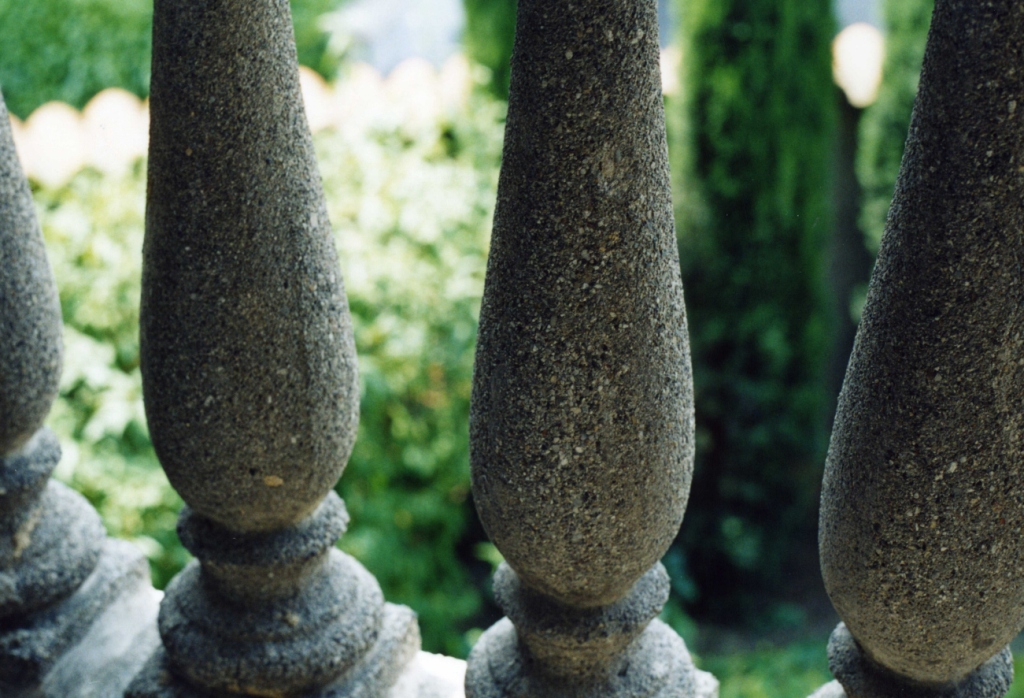CLAUDIO SOTTOCORNOLA
Regarding beauty, care, responsibility…
In March 2003, when my mother unexpectedly left us, in part due to some human errors and omissions, I immediately became aware of the contrast between her way of being — generous, giving, altruistic — and the indifference, cynicism, disinterest that some in our society, even those who should be its protectors and promoters, now express toward human life and its dignity.
I thought about what evidence I could offer to express this experience, what memory, other than a predictable celebration, I could summon of my mother, and it came to me that the garden is a place that is a symbol, a metaphor for her life.
At this point we live amid a civilization of what sociology calls “non places,” from airports to highway intersections, from supermarkets to highway rest stops, from railroad stations to subways, sometimes even a school, a hospital ward or a courtroom can become a non-place. The non-place is characterized by its anomie, by the reduction of people to mere functionality, by the solitude that builds up amid an algid and monstrous mechanism. The garden presents the complete opposite: a place of care and devotion par excellence. The great singer-songwriter Franco Battiato, in his song La cura (Care), beautifully exemplifies this attitude of giving and love:
“I will protect you from fears of hypochondria,
from disturbances that starting from today you will encounter on your way.
From the injustices and deceptions of your time,
from the failures that you by your nature will attract.
I will relieve you of the pains of your mood swings,
the obsessions of your delusions.
I will overcome the gravitational currents,
the space and the light,
to prevent you from growing old.
And I will heal you from all your illnesses,
because you are a special being,
and I, I will take care of you…
Yes, I will take care of you…”
When I think about my mother, whom I want to commemorate with this exhibition, I think of her as someone capable of great care. I remember her this way, for example, when my father became ill and died in far off 1979, but I remember her this way in the everyday aspects of her life that, like the lives of the wise women in the Bible, was always very arduous; yet with her commitment to creating harmony and beauty, even amid the daily haste and obligations, she had an absolute ability to affirm the value of even the smallest but essential aspects of life: you telephoned…, sent greetings…, gave up your seat…, you visited… This is how I learned the grammar of caring. And I must say that all this made me a bit less absent-minded in human relationships.
This is why the garden seemed to me to be the symbol-place, the metaphor for her caring, for her devotion. And thus I believed I saw a materialization of the light and love that my mother transmitted to us with her life in that small garden, that tiny plot of earth extracted from the cement, with which she struggled in every way to tend and strengthen, so much so that those few square meters of grass, plants, flowers, symbolically appear to me today as the most tangible proof that love and commitment can transform every condition, every boundary, into harmony and light, and they constitute an environment where everything shines and resounds with life and love — a garden, in short: the garden.
The garden is the humanization of nature, as Lidia Zitara writes, in the introduction to this multi-media exhibition. It is the place inhabited, interpreted, made familiar by the affection and beauty that resides there, establishing a relationship among its various, harmoniously interwoven elements… There is already beauty in this relationship… And the garden has its own language of perfumes, colors and chiaroscuros; it is mysteriously traversed by thousands of life forms, as Giovanni Pascoli wonderfully evokes in his celebrated poem “Night-Blooming Jasmine”:
“And the night-blooming flowers open,
open in the same hour I remember those I love.
In the middle of the viburnums
the twilight butterflies have appeared.”
And so the garden reveals an essence, a life, and like all places that bear the sign of human presence, it can be a depository of memories, a place of affections, but also an gauge of the seasons… Emily Dickinson, the great American poet who worked during the latter half of the nineteenth century, grasped the garden’s secret code and symbolism; shutting herself off in her beloved family home and in the garden that enclosed it, she spent her entire life breathing in the air derived from the cherished presence that that house and garden revealed.
After my mother’s death, I tried with all the energy I could muster to focus on the light and colors of her garden, the changing of the seasons there, but I also extended my glance, my step, my world out to explore other places that the garden, in turn, has blessed with harmony and life, including those that, thanks to my mother’s example, I have been able to explore and traverse with courage and faith. This is because once one receives assurance, security, what I would almost call the warm proof of being loved, in some ways it becomes easier to notice the warmth of a familiar street, a church, a piazza, a clearing… and also a new landscape. And it is this affective, sacred dimension that is intrinsic to places that my mother succeeded in communicating to me. Yes, because she was the woman who wanted me to exist — who wanted us, me and my sister Augusta — with total intensity, with a creative will and constant striving and effort over the years, over time and over her lifetime and, in her distinctive way, she thus becomes emblematic of an oblational and freely bestowed condition of life.
This is why this exhibition path, made up of images, does not stop at the albeit splendid and privileged place of the garden, but moves on to explore places that have received harmony and life from the light of that garden. Thus there are archetypal places of human experience and my personal experience, the sea, America, snow, the South, childhood places, my native city and the cities of the world… Along this journey, space expands and the places of the world seem to come one after another, evoking an Elsewhere, a horizon that continuously shifts, as I write in one of my poems, and urges us on to continue the journey.
But without that “garden” would I have ever ventured out into the world?
The experience of “care,” which the garden expresses and symbolizes (which is then the experience of the “nest,” of the most cherished affections…) also extends to the entire commitment that pertains to human relationships, and which I have seen exemplified, for example, in my mother’s longstanding commitment, through volunteer work, at the St. Vincent de Paul Society, at the Colognola-Bergamo Conference Center, where she was the Secretary from 1975 to 1990, and President from 1990 to 1994.
I recall, even when her health began to fail a bit, the care and dedication she put into her visits to the elderly in rest homes or to patients in hospitals, sometimes to families in difficulty. For example, there was the sense of joy she derived from helping others, and also her concerns, the way she took on the problems and suffering of others. I cannot forget, for example, her passionate involvement as an interviewer, in the census of the elderly, organized by the municipality of Bergamo in 1984, when she went well beyond the simple gathering of data, to instead establish relationships of cordiality and faith and, when necessary, assistance.
And by analogy I also recall when, as a child, she showed me the same care, as she previously had done for my slightly older sister, a care that went right to the core of things and, at the same time, was attentive to the smallest details.
One of my loveliest memories is when — again when I was a child — my mother, in agreement with father and with the collaboration of my sister, at night while I was sleeping, set out on the living room table some little books, sweets and toys, for the festival of Santa Lucia, which I was thrilled to discover on the morning of December 13th, in an atmosphere already imbued with the spirit of Christmas, of a fairytale and dream.
There too, I now glimpse the signs of the joyous attention she gave to my education, discretely and seriously seeing that I was provided with the best conditions to foster my growth, presenting me not with facile amusements, but rather with a beautiful children’s book with lush illustrations, a musical instrument, a game for learning or one that encouraged my sensitivity and imagination.
It is also thanks to this that I became passionate about art, poetry, music… And I know that my sister and father also played a meaningful role…
Over the years, “care” was expressed in the most wide ranging forms and, when I reached adulthood, it was wonderful, as it is for every child who grows up, to find that “care” demands reciprocity, and that the attention a mother or father pays to a child is what that child, as his or her own life unfolds, must in turn exhibit for the parent. In this way the experience of responsibility emerges and extends to the world around us.
This legacy, this deposit, this testimony is something that will never leave me, and which I believe will accompany me always, even during life’s most trying moments.
Luca Catò, a critic and friend has written a very beautiful text regarding this journey through images, and it is included on the Dvd “Il giardino di mia madre e altri luoghi” (“My Mother’s Garden and Other Places”): “Not in all lives, not always, does one have the good fortune to have a garden. Here there is a good illustration of the ancient myth of “trees pleasing to the eye,” cared for by love. Likewise, here a life can be effectively kindled, guided, so there will be no misunderstandings later… In this sense, again, the garden becomes the first place and the last, the place of memory, of hope, of expectation and of possible beauty.”
But are we always sure — I wonder — that we are putting our efforts, our commitment, our days, into cultivating the garden of our life?
http://www.
May 2010
(In memory of Angela Belloni Sottocornola, taken from C. Sottocornola, “The Gift”, CLD, Italy 2010)
HERE the italian version


